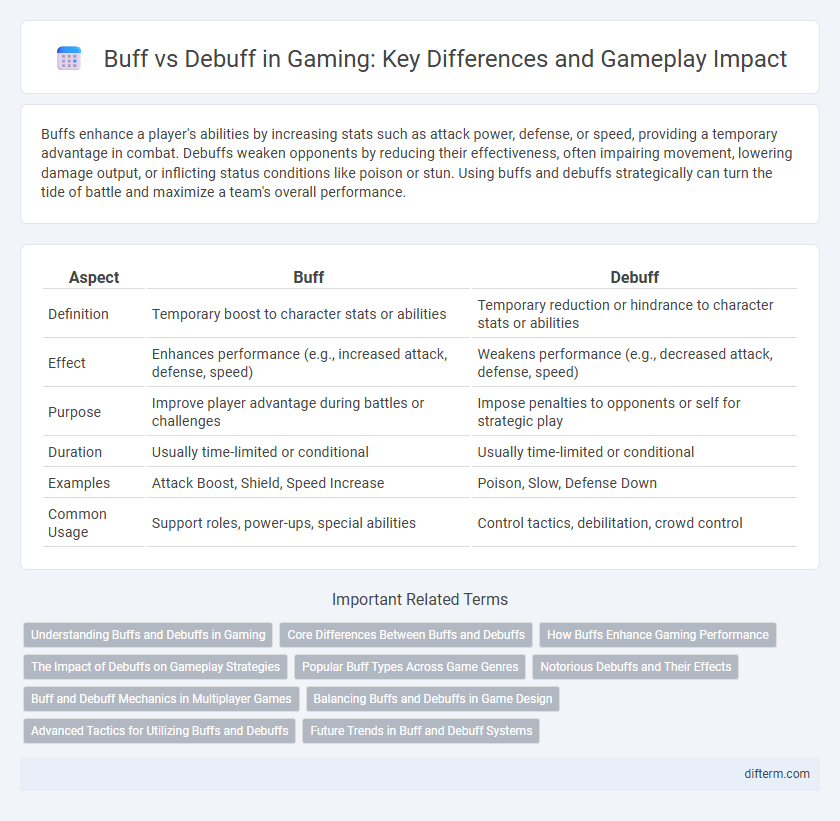Buffs enhance a player's abilities by increasing stats such as attack power, defense, or speed, providing a temporary advantage in combat. Debuffs weaken opponents by reducing their effectiveness, often impairing movement, lowering damage output, or inflicting status conditions like poison or stun. Using buffs and debuffs strategically can turn the tide of battle and maximize a team's overall performance.
Table of Comparison
| Aspect | Buff | Debuff |
|---|---|---|
| Definition | Temporary boost to character stats or abilities | Temporary reduction or hindrance to character stats or abilities |
| Effect | Enhances performance (e.g., increased attack, defense, speed) | Weakens performance (e.g., decreased attack, defense, speed) |
| Purpose | Improve player advantage during battles or challenges | Impose penalties to opponents or self for strategic play |
| Duration | Usually time-limited or conditional | Usually time-limited or conditional |
| Examples | Attack Boost, Shield, Speed Increase | Poison, Slow, Defense Down |
| Common Usage | Support roles, power-ups, special abilities | Control tactics, debilitation, crowd control |
Understanding Buffs and Debuffs in Gaming
Buffs enhance a character's abilities by increasing stats such as attack power, defense, or speed, resulting in improved performance during gameplay. Debuffs, conversely, impose negative effects like reduced health regeneration, slowed movement, or weakened attacks, impairing the opponent's effectiveness. Mastering the strategic application and timing of buffs and debuffs is crucial for gaining a competitive advantage in complex gaming scenarios.
Core Differences Between Buffs and Debuffs
Buffs enhance a player's stats or abilities, such as increased attack power, defense, or speed, providing a temporary advantage during gameplay. Debuffs, in contrast, impose detrimental effects like reduced accuracy, slower movement, or ongoing damage, hindering the player's performance. The core difference lies in buffs boosting effectiveness while debuffs diminish it, directly impacting strategic decisions in games.
How Buffs Enhance Gaming Performance
Buffs improve gaming performance by temporarily increasing a character's abilities such as strength, speed, or defense, allowing players to overcome challenging scenarios more effectively. These enhancements optimize combat efficiency, resource management, and strategic positioning in games like RPGs and MOBAs. By providing measurable boosts to in-game stats, buffs directly influence player success rates and progression speed.
The Impact of Debuffs on Gameplay Strategies
Debuffs significantly alter gameplay strategies by imposing negative status effects that weaken a player's character, such as reduced movement speed, lowered defense, or impaired attack power. These hindrances force players to adapt tactically, prioritizing crowd control, healing, or debuff removal skills to regain advantage. Effective management of debuffs can turn the tide of battles, making them a critical factor in competitive gaming scenarios.
Popular Buff Types Across Game Genres
Popular buff types across game genres include attack power increases, defense enhancements, and speed boosts, which significantly improve player performance in combat scenarios. Health regeneration and mana recovery buffs are commonly used to sustain characters during prolonged battles, while crowd control resistances help maintain control in multiplayer environments. These buffs are integral in role-playing games (RPGs), massively multiplayer online games (MMOs), and real-time strategy (RTS) games to provide tactical advantages and strategic depth.
Notorious Debuffs and Their Effects
Notorious debuffs in gaming often include effects like Damage Over Time (DoT), crowd control impairments such as stuns and silences, and stat reductions like decreased defense or attack power. These debilitating effects can drastically alter combat dynamics by impairing player actions, limiting mobility, and increasing vulnerability to enemy attacks. Understanding the mechanics and duration of notorious debuffs is crucial for effective counterplay and maximizing survivability in challenging encounters.
Buff and Debuff Mechanics in Multiplayer Games
Buff mechanics in multiplayer games temporarily enhance player abilities, such as increased damage, speed, or defense, creating strategic advantages that can turn the tide of battle. Debuff mechanics impose negative effects like reduced accuracy, movement speed, or inflicted damage, often forcing players to adapt their tactics and prioritize support roles. Understanding the timing and synergy of buffs and debuffs is crucial for team coordination, resource management, and maximizing combat effectiveness in competitive gameplay.
Balancing Buffs and Debuffs in Game Design
Balancing buffs and debuffs in game design requires careful calibration of their duration, intensity, and impact on player strategy to maintain fair and engaging gameplay. Effective use of positive buffs can enhance player abilities and encourage aggressive playstyles, while well-designed debuffs introduce strategic challenges and counterplay opportunities. An imbalance in either can lead to frustration or reduced player agency, making iterative testing and player feedback essential for optimal game mechanics.
Advanced Tactics for Utilizing Buffs and Debuffs
Mastering advanced tactics for utilizing buffs and debuffs hinges on precise timing and situational awareness to maximize combat efficiency. Prioritize stacking complementary buffs to amplify damage output while applying strategic debuffs to enemy defenses, such as armor reduction and movement speed penalties. Leveraging synergy between team members' abilities and monitoring buff/debuff durations enhances overall control and sustains battlefield dominance.
Future Trends in Buff and Debuff Systems
Future trends in buff and debuff systems emphasize dynamic, adaptive mechanics driven by AI that tailor effects to individual player strategies and in-game contexts. Developers are integrating real-time data analysis to create more immersive and balanced gameplay experiences, enhancing player engagement through personalized status modifiers. Emerging technologies such as procedural generation and machine learning enable more complex interactions and responsive adjustments within buff and debuff frameworks.
buff vs debuff Infographic

 difterm.com
difterm.com